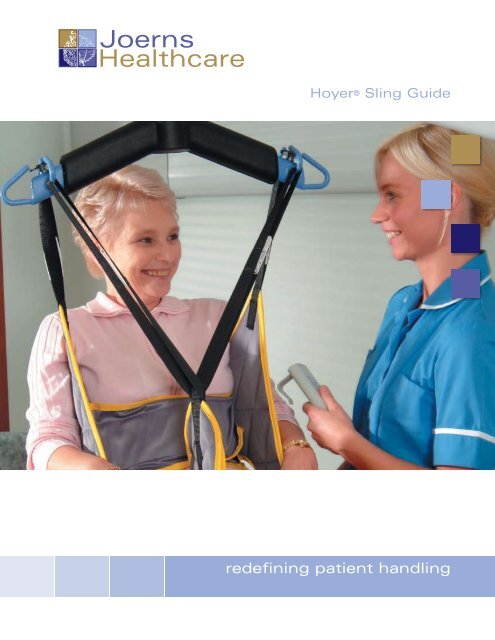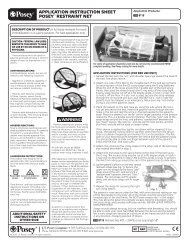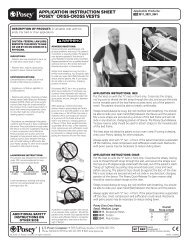Hoyer Sling Guide - Rehabmart.com
Hoyer Sling Guide - Rehabmart.com
Hoyer Sling Guide - Rehabmart.com
You also want an ePaper? Increase the reach of your titles
YUMPU automatically turns print PDFs into web optimized ePapers that Google loves.
Joerns<br />
Healthcare<br />
<strong>Hoyer</strong>® <strong>Sling</strong> <strong>Guide</strong><br />
redefining patient handling
<strong>Hoyer</strong> ®<br />
<strong>Sling</strong> <strong>Guide</strong><br />
Introduction<br />
A sling is an item of moving and handling equipment, which is used with a mechanical lift<br />
in order to facilitate the transfer of a resident. A sling <strong>com</strong>prises a specially designed and<br />
constructed piece of fabric, which is placed under and around a resident before being<br />
attached to the spreader bar/cradle of a lift to raise, transfer and lower the resident.<br />
When selected and used correctly, a sling and lift will achieve a safer transfer, reducing<br />
the risks associated with manual handling.<br />
FIM Score<br />
(Function Independence Measure)<br />
A widely used assessment tool to classify a person’s function<br />
from independence to total assistance in seven levels.<br />
7. Complete Independence<br />
Another person is not required for the activity which is performed safely without<br />
modification or outside assistance within a reasonable time.<br />
6. Modified Independence<br />
Another person is not required for the activity but may need an assistive device,<br />
more than reasonable time giving a risk consideration.<br />
5. Supervision or set up<br />
Someone required to help by observation, encouragement without contact.<br />
4. Minimal Assistance<br />
Someone required to help - by touching - subject makes 75% or more of the effort.<br />
3. Moderate Assistance<br />
Someone required to help by more than touching - subject makes 50% - 75% of the effort.<br />
2. Maximal Assistance<br />
Complete dependence. Subject makes less than 50% but at least 25% of effort.<br />
1. Total Assistance<br />
Complete dependence. Subject makes less than 25% of effort.<br />
Please note that staff in ALL areas must have immediate access to at least one mobile<br />
passive lift for use in the event of an emergency such as the retrieval of a fallen person.<br />
A passive lift suitable for a very heavy person should also be accessible within the facility/<br />
hospital, and all staff should be aware of the system for accessing the lift as required. For<br />
example, in the event of an unplanned admission of a very heavy resident into Accident<br />
and Emergency.<br />
Please note:<br />
It is very important to use the correct sized sling and ensure it is properly fitted before attempting to<br />
lift. This will ensure the person being lifted feels safe, dignified and <strong>com</strong>fortable. It will also provide the<br />
caregiver with confidence that they can achieve the transfer that they wish and that the procedure will be<br />
executed in an effective and safe manner.This guide aims to assist those responsible for the provision<br />
of slings by outlining some key factors to be addressed in the selection of the most appropriate type of<br />
sling for a resident. Guidance is then given as to which sling from the HOYER range will best meet these<br />
requirements. HOYER has an extensive range of slings. Our slings are a reflection on many years of<br />
refinements that make our range one of the most <strong>com</strong>fortable and flexible in the market place today.<br />
2<br />
www.joerns.<strong>com</strong> | info@joerns.<strong>com</strong>
<strong>Hoyer</strong> ®<br />
<strong>Sling</strong> <strong>Guide</strong><br />
<strong>Sling</strong> Models<br />
The <strong>Hoyer</strong> range of slings has been designed with a number of features aimed at meeting varied lifting requirements and applications.<br />
Each sling is described briefly below. Note FIM scores have been provided as an assessment tool to classify a person’s function from<br />
independence to total assistance in 7 levels.<br />
Quick fit/Universal <strong>Sling</strong><br />
(Spreader Bar: 6 Point)<br />
This sling is an easy-to-fit, general-purpose<br />
sling designed to suit 85% of residents. It is<br />
simple to use and is available in all sizes from<br />
XS to XL. FIM Scores: 1 and 2 and any other<br />
person from the floor<br />
Quick Fit Deluxe <strong>Sling</strong><br />
(Spreader Bar: 6 Point)<br />
This sling is a development of the Quick Fit<br />
design and is suitable for 95% of residents.<br />
It can be used for amputees following<br />
assessment, and is available in all sizes from<br />
XS to XL. FIM Scores: 1 and 2 and<br />
any other person from the floor<br />
Access/Toileting <strong>Sling</strong><br />
(Spreader Bar: 6 Point)<br />
This sling is designed specifically to facilitate<br />
the toileting procedure by allowing the removal<br />
of clothing. It is NOT a general-purpose sling<br />
and will suit only 25% of residents. Residents<br />
must be in a sitting position to use this sling.<br />
FIM Scores: 2 or 3 following<br />
careful assessment<br />
An assessment MUST be carried out when<br />
using the access sling as it can be dangerous<br />
when used on the wrong resident.<br />
Full Back<br />
(Spreader Bar: 6 Point)<br />
This is a more specialized sling. It incorporates<br />
integral boned head support and padded leg<br />
pieces and is available in all sizes from XS to<br />
XL. The correct size will fit snugly and give full<br />
protection for residents who go into extension,<br />
or have involuntary movements or behavioral<br />
problems. FIM Scores: 1 and 2 and<br />
any other person from the floor<br />
Comfort <strong>Sling</strong><br />
(Cradle: 4 Point)<br />
This is a more specialized sling. It allows<br />
correct positioning to be made via the 4-point<br />
cradle and uses the Securi3 sling connection<br />
system ensuring no inadvertent detachment<br />
of the sling from the cradle. It incorporates a<br />
removable <strong>com</strong>fort pad for head support and<br />
snuggles the resident providing full protection<br />
for residents who go into extension or have<br />
involuntary movements or behavioral problems.<br />
It is available in all sizes from XS to XL.<br />
FIM Scores: 1 and 2 and any other person<br />
from the floor<br />
Standing <strong>Sling</strong> (Stand-aid)<br />
The standing sling is suitable for those<br />
residents who have a greater degree of weight<br />
bearing ability. It allows excellent access for<br />
toileting and is easy to fit, providing quick and<br />
effective transfers. The adjustable waist strap;<br />
the non-slip back pad ensures the sling does<br />
not ride up during the transfer. This sling can<br />
be dangerous, however, when used with the<br />
wrong resident, so a careful risk assessment is<br />
advised. FIM Scores: 3 and 4<br />
Transport <strong>Sling</strong><br />
(Stand-aid)<br />
The transport sling is suitable for those<br />
residents with a degree of weight bearing<br />
ability. It is easy to fit, allowing quick and<br />
effective transfers. The adjustable waist strap.<br />
FIM Scores: 2, 3 and 4<br />
www.joerns.<strong>com</strong> | info@joerns.<strong>com</strong><br />
3
<strong>Hoyer</strong> ®<br />
<strong>Sling</strong> <strong>Guide</strong><br />
<strong>Hoyer</strong> <strong>Sling</strong> Features<br />
Colored binding provides clear recognizable<br />
size information.<br />
Colored loop straps, which provide adjustment<br />
and the correct angle positioning for the 6-point<br />
spreader bar system.<br />
Clear labels provide all the information required together<br />
with a line drawing showing how our slings fit.<br />
1 2<br />
Leg support widths (1) offer optimal support, while not cutting into the knee or groin area, and<br />
modesty loops (2) stop the residents legs from splaying while transferring.<br />
Centerline markers aid the caregiver in the correct<br />
positioning of the sling, especially when inserting<br />
the sling before an off the bed or floor transfer.<br />
Made from polyester, <strong>Hoyer</strong> slings are durable, soft and <strong>com</strong>fortable. Padding provides<br />
additional <strong>com</strong>fort and support to delicate areas and our webbing straps have covered ends<br />
to protect residents’ skin.<br />
The angle of the straps has been carefully<br />
calculated to ensure the correct posture<br />
and <strong>com</strong>fort of the resident.<br />
Head supports ensure correct<br />
positioning during transfer.<br />
Mesh slings are ideal in wet environments,<br />
providing rapid draining and drying.<br />
4<br />
www.joerns.<strong>com</strong> | info@joerns.<strong>com</strong>
<strong>Hoyer</strong> ®<br />
<strong>Sling</strong> <strong>Guide</strong><br />
HOYER has many <strong>com</strong>mon attributes that make our slings easier to use, and easier to train with.<br />
Handles on the sides of our slings are optimized to ensure correct handling. The grey color of our<br />
slings means contamination is easy to spot - but the polyester fabric isn’t prone to staining, and is<br />
easily laundered.<br />
Cradle Options<br />
The <strong>Hoyer</strong> professional lift range has the option of two cradles that provide the caregiver greater choice in selecting the most appropriate sling and<br />
cradle for the task. The Presence and Stature can be used with either the 6-point spreader bar or the 4-point positioning cradle.<br />
The 6-point spreader bar uses slings with webbing loops,which allow positioning adjustments to be<br />
made by selecting the different colored loops. The attachment straps at shoulder level determine<br />
the position of the back, ranging from upright through to semi-reclined and reclined. Similarly, the<br />
attachment straps at the legs determine the approximate degree of flexion at the hip, from<br />
around 45° to 90°.<br />
6-point spreader bar<br />
The position achieved by adjusting the loops will depend upon the height and build of the resident.<br />
The rule of thumb is the shorter the shoulder straps the more upright the resident will be.<br />
Alternatively the 4-point positioning cradle uses the Securi3 safety clip system and adjustment is<br />
made by rotating the cradle handle either down or up to obtain an upright or reclined position for<br />
the resident.<br />
Note: The Comfort sling utilizes the Securi3 clip system and this was especially designed to ensure<br />
NO inadvertent detachment occurs. The 3 key stages assure the resident and caregiver of safety<br />
and <strong>com</strong>fort positioning throughout the transfer.<br />
4-point positioning cradle<br />
Both cradles have their place, but more importantly it allows the caregiver to<br />
choose exactly the correct sling for the resident and task in question.<br />
www.joerns.<strong>com</strong> | info@joerns.<strong>com</strong><br />
5
<strong>Hoyer</strong> ®<br />
<strong>Sling</strong> <strong>Guide</strong><br />
Range of Sizes<br />
Most slings are available in a range of sizes to ac<strong>com</strong>modate variety in<br />
height, shape and weight of residents. All these factors must be taken into<br />
consideration when selecting the appropriate sling for the residents. Sizes<br />
are available from XS to XL and full details on our slings can be found in<br />
our order form.<br />
Weight Capacity<br />
Stated on the label is the safe working load, 500 lbs.<br />
Some slings vary, so always check the label before use.<br />
Extra Small<br />
Small<br />
Medium<br />
Large<br />
Extra Large<br />
XS<br />
S<br />
M<br />
L<br />
XL<br />
Identification Label<br />
The identification label provides essential information about the sling such as:<br />
•<br />
•<br />
•<br />
•<br />
•<br />
Model reference number<br />
Type of sling<br />
Size<br />
Testing mark CE or similar<br />
Date of Manufacture<br />
Care Instructions<br />
Safe Working Load (SWL)<br />
Bar code<br />
Identification picture<br />
Note: Space provided for a unique Serial Number that enables traceability,<br />
which can be used for inspection and audit records.<br />
•<br />
•<br />
•<br />
•<br />
User <strong>Guide</strong><br />
A detailed User <strong>Guide</strong> is provided with all slings. It contains<br />
essential information concerning machine washing and general<br />
care of the sling.<br />
<strong>Sling</strong> Safety Information (guidance)<br />
•<br />
•<br />
•<br />
•<br />
•<br />
Maximum wash temp: 185°F (85°C), non-enzyme detergent<br />
Wash 160°F (71°C) for 3 minutes<br />
Wash 145°F (63°C) for 10 minutes<br />
Do not tumble dry at high temp - Air dry, cool tumble dry or<br />
dry at very low temperature<br />
Ability to wash may help against MRSA<br />
Size & Weight Range <strong>Guide</strong><br />
(Approx.)<br />
Please note the following sling guides are re<strong>com</strong>mendations only. A<br />
full risk assessment must be conducted before any sling is selected.<br />
This will ensure safety for the resident and the caregiver.<br />
<strong>Sling</strong> Range<br />
Weight Re<strong>com</strong>mendation Chart (GUIDE)<br />
Values shown: kgs/lbs<br />
Low High Range<br />
kg lb kg lb kg lb<br />
XS 16 35 45 100 29 65<br />
S 34 75 68 150 34 75<br />
M 57 125 91 200 34 75<br />
L 80 175 136 300 57 125<br />
6<br />
www.joerns.<strong>com</strong> | info@joerns.<strong>com</strong>
<strong>Hoyer</strong> ®<br />
<strong>Sling</strong> <strong>Guide</strong><br />
Other Considerations for <strong>Sling</strong>s<br />
Alternative fabrics are available as SPECIAL ORDERS. However, there is<br />
an extended lead-time for these (typically 4-5 weeks). Consult your <strong>Hoyer</strong><br />
representative for details.<br />
Special <strong>Sling</strong>s<br />
Special slings are “one-off” designs to meet specific requirements of<br />
individual residents and can be made to order. The following specials can<br />
be ordered.<br />
•<br />
•<br />
•<br />
•<br />
•<br />
Extend loop strap length to suit leg or shoulders<br />
Add loop to suit<br />
Remove head support<br />
Taper leg section<br />
Add lining to legs or body (synthetic fleece material)<br />
•<br />
<strong>Sling</strong><br />
Prescription<br />
Sheets<br />
<strong>Sling</strong> prescription sheets are<br />
available upon request to facilitate<br />
producing a special sling design.<br />
Example of sling prescription form.<br />
<strong>Sling</strong> Support Levels and<br />
Commode Openings<br />
Different types of slings provide different levels of support for the<br />
resident being lifted. The support level is determined by the shape and<br />
structure of the fabric, with the main body of the sling providing support<br />
to the back and head (photo 1) and the leg straps providing support to<br />
the thighs, hips and buttocks (photo 3/4). The shape of the sling will<br />
also determine the presence and size of a <strong>com</strong>mode opening.<br />
(figure 2 below).<br />
1 2<br />
3 4<br />
Clinical<br />
Support/Advice<br />
Clinicians are available upon<br />
request to assist Joerns Healthcare<br />
customers by providing clinical<br />
information and advice in relation<br />
to <strong>Hoyer</strong> slings and<br />
other products.<br />
Moving and Handling Training<br />
The correct equipment coupled with appropriate training can help to<br />
minimize the risks associated with manual handling. Joerns Healthcare<br />
has developed a <strong>com</strong>prehensive range of moving and handling training<br />
programs aimed at meeting the needs of all caregivers. Programs are<br />
flexible, with courses designed to suit individual circumstances and needs.<br />
The overall aim is to create “a safer environment”.<br />
Selecting the Best Type of <strong>Sling</strong><br />
Selecting a sling for an individual resident involves more than simply<br />
measuring their size and deciding what the sling will be used for.<br />
Basic factors to take into consideration are the level of support required<br />
from the sling and whether a <strong>com</strong>mode opening is necessary. However,<br />
to be sure that a sling meets specific requirements and is the most<br />
appropriate sling available, many further aspects need to be considered<br />
as part of the selection process. Some of these are discussed<br />
briefly here.<br />
Information about the task(s)<br />
In order to be sure the sling selected will be suited to its required use, it<br />
is necessary to determine the type of transfer task(s) desired, together<br />
with the frequency with which they will occur. This relates closely to the<br />
functional requirements of the sling. For instance: a sling that is to be<br />
used for toileting will require a <strong>com</strong>mode opening.<br />
www.joerns.<strong>com</strong> | info@joerns.<strong>com</strong><br />
7
<strong>Hoyer</strong> ®<br />
<strong>Sling</strong> <strong>Guide</strong><br />
Information About the Caregiver(s)<br />
When selecting slings, it is important to be mindful of the<br />
person(s) who will be fitting the sling and using the lift. Their<br />
abilities and limitations - especially experience and training - must<br />
be considered. Some slings are more <strong>com</strong>plicated than others to<br />
fit and a caregiver may be reluctant to use a sling if the process<br />
of fitting it is too <strong>com</strong>plex. The number of caregivers available to<br />
fit the sling as well as the total number of caregivers involved in a<br />
residents’ care may also be important considerations - a range of<br />
caregivers may have a range of capabilities.<br />
Information About<br />
Other Equipment<br />
It is necessary to establish the sling’s <strong>com</strong>patibility with other<br />
equipment, especially the lift and the lifting system. It is also<br />
important to identify any associated equipment involved in<br />
transfers, such as seating, beds, gurneys, toilets, and therapy<br />
equipment, to ascertain that the lift and sling will work effectively<br />
with these items.<br />
Selecting the Type of <strong>Sling</strong> for<br />
the Most Common Task<br />
To simplify the process of sling selection, HOYER has developed<br />
a chart to guide you in the appropriate use of each sling and task.<br />
There will, of course, be exceptions to this guide, but this reference<br />
enables a view of what tasks can be <strong>com</strong>pleted.<br />
1) Use only with a net version<br />
<strong>Sling</strong> Type<br />
Access<br />
Quick Fit<br />
Del<br />
Quick Fit<br />
Full Back<br />
HOYER<br />
Lift<br />
Advance/<br />
Presence<br />
Advance/<br />
Presence<br />
Advance/<br />
Presence<br />
Advance/<br />
Presence<br />
Toilet<br />
Commode<br />
to bath 1<br />
Chair<br />
to Chair<br />
Bed<br />
to Chair<br />
Floor<br />
to Bed<br />
Chair to<br />
Commode<br />
n n n<br />
n n n n<br />
n n n n<br />
n n n n<br />
Comfort Stature n n n n n<br />
Standing Arise n n n n<br />
Transport Arise n n n n<br />
About Joerns Healthcare<br />
Joerns Healthcare provides the <strong>com</strong>plete solution to moving and<br />
handling with a range of <strong>com</strong>patible lifts, slings and accessories<br />
designed to meet the needs of both resident and caregiver.<br />
Besides <strong>Hoyer</strong> slings, the Joerns Healthcare moving and<br />
handling range includes:<br />
•<br />
•<br />
•<br />
•<br />
Ceiling mounted lifts<br />
Mobile lifts<br />
Extended warranty and service options<br />
Moving and handling training packages<br />
We trust you have found this guide both useful and informative.<br />
Joerns Healthcare Inc.<br />
5001 Joerns Drive, Stevens Point WI 54481<br />
(P) 800.826.0270 • (F) 800.457.8827<br />
www.joerns.<strong>com</strong> • email: info@joerns.<strong>com</strong><br />
© 2007 Joerns Healthcare | Part# 6190024 RevB | DCO# 07-0588







